The Beauty of Bengali Temples - Part 3
BY: SUN STAFF
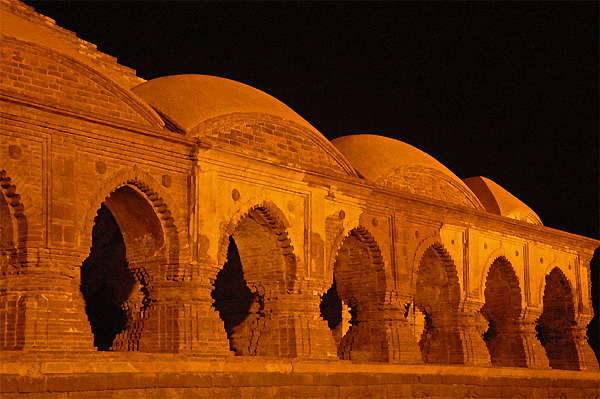
RasMancha Temple, Bishnupur
Sep 30, CANADA (SUN) — In the book"Temples and Legends of Bengal", author P.C. Roy Choudhury writes, "All temples have their periods of glory and decay, and this is often the fate of those temples that are set up by and propped up ruling chiefs or an aristocrat landlord. The decline of the family with whose prestige, wealth and power the temple is intimately associated means the decline of the temple also.
Ultimately the temple, once a place of worship, pomp and glory becomes the scene of desolation, ruin and nostalgia. Even the images are desecrated or removed, the carved walls and other pieces of sculpture are taken out and utilized elsewhere. Jungles grow and jackals stalk in the area where once temple-bells used to jingle with the chant of mantras."
The glorious legacy of West Bengal's temples is slowly falling into disrepair, and many fine brick and terracotta temples have returned to dust. Others are in various states of degeneration, which the minority get proper (or reasonable) attention, and are still actively supported be congregants. Before they are destroyed by Kala, Vaisnavas who are traveling to Bengal will want to take advantage of the remaining temple sites, which can be visited across the length and breadth of West Bengal. Following is a partial list of West Bengal's temples, some with descriptive passages from Choudhury's book or other sources.
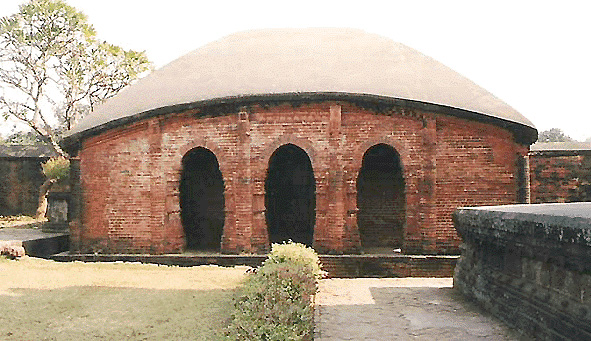
Temple in Bishnupur
West Bengal Temples
Bakranath Temple at Bakreswar near Siuri in West Bengal: Built in the Oriyan style, this large temple is the most important of the several shrines in Bakreswar. Hot springs are another feature of interest in this town.
Balrampur Jain Temple at Balrampur near Purulia in West Bengal
Bankura Temples - THE present Bankura district is the heart of the ancient Summha area of Mahabharat or Rarh or Larh of the old Jain Acharanga-sutra. Rarh Desh was described to have two areas, namely, Bajjabhumi and Summhabhumi. In the Buddhist Jatakas also there is mention of Summhabhumi. The present district of Bankura has the districts of Purulia, Burdwan, Hooghly and Midnapore at her borders.
The district lies in between the hills and terrains of Chotanagpur and Santal Parganas in Bihar on one side and the alluvial fertile land of Bengal on the other. The physiographical features of this district are partially available in the bordering districts of Midnapur and Purulia. Rarh Desh covers parts of other districts in Bengal, which adjoins Bankura District 1.
Bansuli Temple at Nannur near Bolpur in West Bengal: The temple site is like a mound, and the lowest level dates back to the Gupta period.
Barakar Temples at Barakar near Asansol in West Bengal: Four stone temples in the North Indian Rekha style built in the 8th through the 15th century.
Bargabhima Temple at Tamluk near Medinipur in West Bengal: Large Temple to Shakti influenced by the Oriyan architecture style displaying interesting engineering and architectural features.
Bhagwati Temple at Gourangpur near Asansol in West Bengal: A beautiful brick temple over 150 years old, now deserted.
Brindabanchandra Temple at Guptipara near Calcutta (Hooghly) in West Bengal: The biggest in the group of temples in Guptipara.
Chaitanyadev Temple at Guptipara near Calcutta (Hooghly) in West Bengal: 17th century temple in the Bengali style of architecture.
Chinese Temple at Achipur near Calcutta in West Bengal: Chinese temple with inscriptions dating back to the 18th century.
Dakshineswar Kali Temple at Calcutta in West Bengal: Famous 19th century Kali temple associated with Ramakrishna. The Kali temple is of fairly recent origin (1847), and it is representative of Bangla temple architecture, with a cluster of towers, with a central dome towering above the rest, with a two layered roof - one superimposed on the other, with four domes in four corners of each, with a corridor with a curvilinear roof in between each pair of domes. Across the Hooghly river from Dakshineshwar, on its west bank, is Belur Math, the headquarters of the Ramakrishna Mission. Following Ramakrishna's passing in 1886, Swami Vivekananda founded the mission.
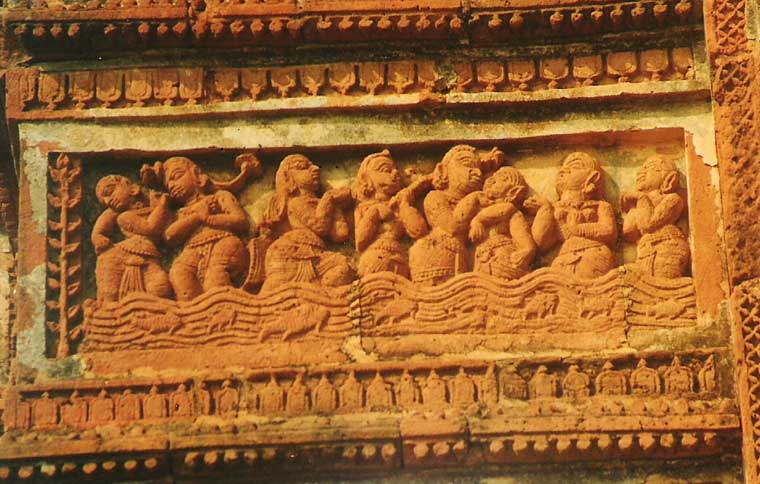
Terracotta Panel of Rasa Lila Pastimes
Dhirdham Temple at Darjeeling in West Bengal: Built along the lines of the Pasupathinath temple in Nepal.
Dugdheshwar Shiva Temple at Amaragarh near Bardhaman in West Bengal
Ekteswara Temple at Ekteswara near Bankura in West Bengal: Famous Shiva temple that looks like a massive solid pillar near the river Dwarkeshwar. Ekteshwar enshrines Shiva in the form of Ekapaadamurthy, with one foot and two hands. Legend has it that that there was a lot of rivalry between two local rulers Samantabhuma and Mallabhuma over the border between their kingdoms. It is said that Shiva appeared in the form of an image of Ekapadamurthy at a point between their kingdoms thereby resolving the border dispute. The temple seen today is a result of renovation and restoration over a period of time. The original laterite structure has brick and sandstone additions. In structure, it represents the architectural style of Orissa, bereft of a spire. In addition, there are a series of brick arches in front of the temple. The sanctum is reached after descending through a flight of steps. The temple looks like an abrupt upright structure, devoid of major sculptural work.
Hanseswari Temple at Bansberia near Calcutta in West Bengal: Dates back to the 19th century with ornate arches.
Mahesh Sri Jagannath Temple at Serampore near Calcutta in West Bengal: Large and ancient Jagannath temple famous for its rath yatra, second only to Puri. Mahesh Ratha Yatra is very famous. Lord Sri Krishna himself is said to have come here as a baby boy to the sweets shop of Mahesh Chandra Datta in Serampore. After eating sweets, He entered this temple and disappeared. Sri Gouranga and many others came here to see the famous Rath Yatra of Sri Jagannath of Mahesh.
Jain remains at Pakbira near Bara Bazar (Purulia) in West Bengal: Remains of numerous temples and images some about 2000 years old.
Jain Temple Ruins at Boram near Jaipur in West Bengal: Ruins of three identical Jain temples
Jain Temples at Dulmi near Purulia in West Bengal
Jain Temples at Deoli near Purulia in West Bengal: Group of Jain temples, the largest of which has an image of Arhanath worshipped by Hindus as well.
Jain temples and ruins at Chharra near Purulia in West Bengal: Old temples and ruins of Jain origin.
Jateshwarnath Temple at Mahanad near Calcutta (Hooghly) in West Bengal: A center for Shiva and Shakti worship.
Jaya Deva Temple at Kenduli near Bolpur in West Bengal: Well known temple to Radha and Krishna dating back to the 12th century - current structure over 200 years old.
Jor Bangala Temple at Bishnupur near Bankura in West Bengal: Specimen of remarkable sculpture and architecture.
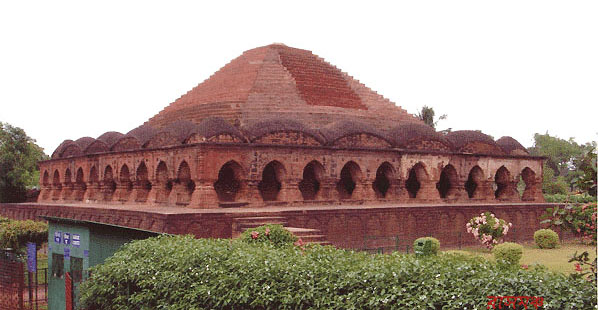
RasMancha Temple
Kalighat Temple at Calcutta in West Bengal: 200 year old temple from which Calcutta is said to take its name. Kali is regarded as one of the principal deities of Bengal. There are other temples to Kaali - Sahasrabhuja Kaali, Sarvamangala, Tarasundari and Simhavaahini. Kaali is regarded as the destroyer or liberator and is depicted in a fearful form. Despite the terrifying form, she is considered to deliver bliss to worshippers. Kalighat is regarded as one of the 52 Shakti Peethams of India, where the various parts of Sati's body are said to have fallen, in the course of Shiva's Rudra Tandava. Kalighat represents the site where the toes of the right foot of Shakti or Sati fell.
The Kalighat temple in its present form is only about 200 years old, although it has been referred to in Mansar Bhasan composed in the 15th century, and in Kavi Kankan Chandi of the 17th century. It is said that a devotee discovered a luminant ray of light coming from the Bhagirathi river bed, and upon investigating its source came upon a piece of stone carved in the form of a human toe. He also found a Syayambhu Lingam of Nakuleshwar Bhairav nearby, and started worshipping Kaali in the midst of a thick jungle. This shrine grew to its present form over a period of time, thanks in particular to the Sabarna Roy Chowdhury family of Bengal. This family is also said to have built the Chitreswari Kaali temple at Chitpur. It is believed that there was a pathway through the jungle between Chitpur and Kalighat, and this pathway is said to have become the Chitpur road of Calcutta. Kalighat is also associated with the worship offered to Kaali by a Dasanami Monk by name Chowranga Giri, and the Chowringee area of Calcutta is said to have been named after him.
Kalna Shiva Temples at Kalna in West Bengal: A group of 108 Shiva temples in concentric circles.
Kalyaneshwari Temple at Barakar near Asansol in West Bengal: This is a 500 year old temple a great center for Shakti worship.
27 Kanak Durga Temple at Chikligarh near Medinipur in West Bengal
Kapil Muni Temple at Sagar Island near Diamond Harbor in West Bengal: Associated with the descent of the Ganges from the heavens (into the sea) and a site held in great reverence.
Kiriteshwari Temple at Murhsidabad near Murshidbad in West Bengal: Regarded as one of the Shakthi Peeths this was once a center of great importance.
Krishnachandra Temple at Guptipara near Calcutta (Hooghly) in West Bengal: Located along with the Chaitanyadev, Ramachandra and Brindabanchandra temples.
Krishnarjun Temple at Tamluk near Medinipur in West Bengal: Ancient temple - current structure built 400 years ago.
Lakshmi Narayan Temple Tarakeswar: Beside the temple of Lord Shiva's Tarakeswar temple there is a small temple of Lakshmi Narayan. The temple deity looks like Radha Krishna but the deity Radha is worshipped as goddes Laxmi, and Lord Krishna is worshipped as Narayan.
Lalji Temple at Chandrakona near Medinipur in West Bengal: 16th century temple built in Bengali style, enclosed by a high wall with a gateway.
Malleswar Temple at Chandrakona near Medinipur in West Bengal: 60 feet high temple dating back to the 18th century, with an even older shrine.
Mankeshwar Mahadev Temple at Amaragarh near Bardhaman in West Bengal.
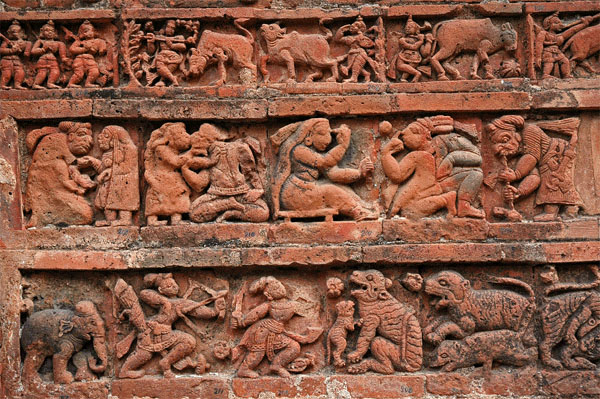
Terracotta Panel, Jor-bangala Temple
Radha Kanta Jiu Temple at Rajbalhat near Calcutta (Hooghly) in West Bengal: A fine specimen of Bengali architecture dating back to the 18th century.
Radha Krishna Temple of Chatra Doltala: One of the famous Radha Krishna temples of Bengal where Bhagwan Sri Krishna Chaitanya Himself came to offer Puja. This temple is more than five hundred years old.
Ramachandra Temple at Guptipara near Calcutta (Hooghly) in West Bengal: Fine red coloured brick temple with a curved roof, with brick panels carved with fine specimen of Bengali art.
Sarva Mangala Devi Temple at Garbeta near Medinipur in West Bengal: 16th-17th century temple in the Oriyan style dedicated to Devi along with other temples within the fort.
Sheetalnath Jain Temple at Calcutta in West Bengal: 19th century temple - an ornate mass of mirrors, coloured stones and glass mosaics.
Shivakhya Devi Temple at Amaragarh near Bardhaman in West Bengal
Sidheswara Temple at Bahulara near Onda in West Bengal: Ancient Shiva temple in the Oriyan style with fine ornamentation depicting replicas of the temple.
Suratheshwar Temple at Supur near Bolpur in West Bengal
Swayambhava Kali Temple at Bansberia near Calcutta (Hooghly) in West Bengal: Located near the Vishnu temple, this temple dates back to the 18th century.
Syamaleswar Temple at Dantan in West Bengal: Ancient temple to Shiva in this town where there are 2 large tanks - the Bidyadhar and Sarasankha. This temple is located very close to the border and the temple displays a profound Oriyan influence. Dantan is said to have been an active center of trade, on the pilgrim route to Puri from Bengal, attracting a lot of travelers. Dantan was a thriving center during the period of Lord Chaitanya, it is locally said that the religious leader halted here on his way to Puri and brushed his teeth here, hence the name Dantan. In this village are two tanks, the Vidyadhar and the Sarasankha tank. The Vidyadhar tank is said to have been created by the minister of the ruler Pratapa Rudra of Warangal. The temple is representative of the Oriyan temple culture. Facing the temple is a large Nandi, now in a damaged state.
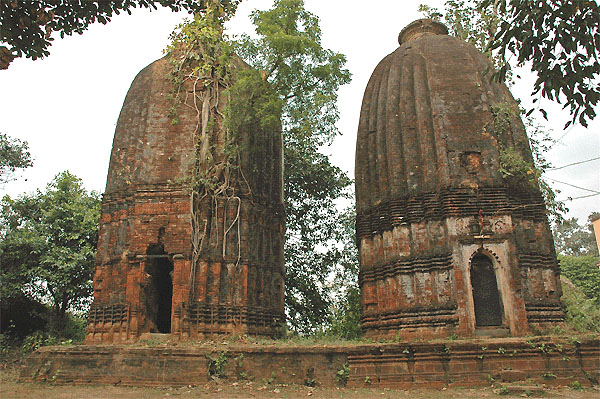
Bishnupur Jor-MandirTemples
Tarakeshwar Temple at Tarakeshwar near Calcutta (Hooghly) in West Bengal: A very well known temple in the Bengali style of architecture attracting scores of pilgrims. This temple dates back to the 18th century. A devotee named Vishnu Das had emigrated with his clan from Oude (Ayodhya) and was viewed with suspicion by the locals. It is believed that he proved his innocence by holding in his hand a red hot iron bar. Later, his brother discovered a site in the nearby jungle, where cattle discharged the contents of their udders at a particular spot each day. Upon investigation, they discovered a Shivalingam. A dream is said to have revealed to them that this Shivalingam was a manifestation of Tarakeshwar (Shiva). A temple was built at this spot, and was renovated in subsequent years. This temple is typical of Bengali temples, with a sanctum and a porch in front of it. The four sided porch has three arched openings railings on its roof. In front of the porch is the congregational hall.
Temple Ruins at Chandrakona at Chandrakon near Medinipur in West Bengal: Ruins of several Oriyan styled temples now abandoned.
